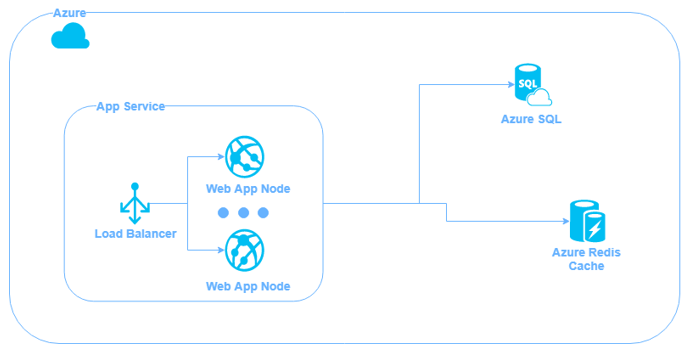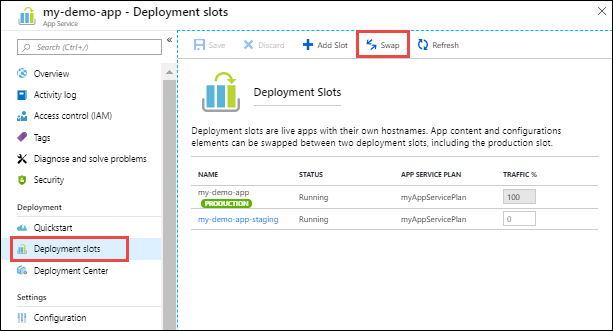Azure Sites Slots
This post explains some of the not so well-known features and configurations settings of the Azure App Service deployment slots. These can be used to modify the swap logic as well as to improve the application availability during and after the swap. Here is what you can do with them:
Azure Function App Slots
Swap based on the status code
Azure Websites recently added support for multiple deployment 'slots' like Dev, Test, Staging. Daria Grigoriu shows Scott how this works and we look at scenarios where slots can be useful. 08 min, 53 sec View more Azure Friday videos. When you deploy your web app to App Service, you can deploy to a separate deployment slot instead of the default production slot when running in the Standard or Premium App Service plan mode. Slot configuration in Azure (GUI edition) Log in to the Azure Portal and navigate to the website you wish to add a slot. Click on the Settings tile, scroll down and find the Testing in production tile under the Configuration section. On the newly openned blade, click on Add Slot. One great feature of Azure Web Apps is deployment slots. I recently had an excellent use case for them as a small startup I’m working with is trying out ASP.NET MVC.
During the swap operation the site in the staging slot is warmed up by making an HTTP request to its root directory. More detailed explanation of that process is available at How to warm up Azure Web App during deployment slots swap. By default the swap will proceed as long as the site responds with any status code. However, if you prefer the swap to not proceed if the application fails to warm up then you can configure it by using these app settings:
WEBSITE_SWAP_WARMUP_PING_PATH: The path to make the warm up request to. Set this to a URL path that begins with a slash as the value. For example, “/warmup.php”. The default value is /.WEBSITE_SWAP_WARMUP_PING_STATUSES:Expected HTTP response codes for the warm-up operation. Set this to a comma-separated list of HTTP status codes. For example: “200,202” . If the returned status code is not in the list, the swap operation will not complete. By default, all response codes are valid.
You can mark those two app setting as “Slot Settings” which would make them remain with the slot during the swap. Or you can have them as “non-sticky” settings meaning that they would move with the site as it gets swapped between slots.
Minimize random cold starts

In some cases after the swap the web app in the production slot may restart later without any action taken by the app owner. This usually happens when the underlying storage infrastructure of Azure App Service undergoes some changes. When that happens the application will restart on all VMs at the same time which may result in a cold start and a high latency of the HTTP requests. While you cannot control the underlying storage events you can minimize the effect they have on your app in the production slot. Set this app setting on every slot of the app:
WEBSITE_ADD_SITENAME_BINDINGS_IN_APPHOST_CONFIG: setting this to “1” will prevent web app’s worker process and app domain from recycling when the App Service’s storage infrastructure gets reconfigured.
The only side effect this setting has is that it may cause problems when used with some Windows Communication Foundation (WCF) application. If you app does not use WCF then there is no downside of using this setting.
Control SLOT-sticky configuration
Originally when deployment slots functionality was released it did not properly handle some of the common site configuration settings during swap. For example if you configured IP restrictions on the production slot but did not configure that on the staging slot and then performed the swap you would have had the production slot without any IP restrictions configuration, while the staging slot had the IP restrictions enabled. That did not make much sense so the product team has fixed that. Now the following settings always remain with the slot:
- IP Restrictions
- Always On
- Protocol settings (Https Only, TLS version, client certificates)
- Diagnostic Log settings
- CORS
If however for any reason you need to revert to the old behavior of swapping these settings then you can add the app setting WEBSITE_OVERRIDE_PRESERVE_DEFAULT_STICKY_SLOT_SETTINGS to every slot of the app and set its value to “0” or “false”.
swap Diagnostics detector
If a swap operation did not complete successfully for any reason you can use the diagnostics detector to see what has happened during the swap operation and what caused it to fail. To get to it use the “Diagnose and solve problems” link in the portal:
Azure Sites Slots Games
From there click on “Check Swap Operations” which will open a page showing all the swaps performed on the webapp and their results. It will include possible root causes for the failures and recommendations on how to fix them.

Azure App Service Slot
The Essential Guide to Microsoft Teams End-User Engagement
We take you through 10 best practices, considerations, and suggestions that can enrich your Microsoft Teams deployment and ensure both end-user adoption and engagement.
Every Azure Website (recently renamed App Service) comes with a default deployment slot – production. Did you know that you can create up to 4 additional deployment slots to be used for dev, test, QA, or staging?
Deployment slots are actually live web apps with their own hostnames. Web app content and configurations elements can be swapped between two deployment slots. Benefits of deployment slots include:
- You can validate web app changes in a staging deployment slot before swapping it with the production slot.
- Deploying a web app to a slot first and swapping it into production ensures that all instances of the slot are warmed up before being swapped into production. This eliminates downtime when you deploy your web app. The traffic redirection is seamless, and no requests are dropped as a result of swap operations.
- After a swap, the slot with previously staged web app now has the previous production web app. If the changes swapped into the production slot are not as you expected, you can perform the same swap immediately to get your “last known good site” back.
Stay tuned for more Azure Did You Know’s. Contact us at Perficient to have a certified Azure consultant help envision your solution today!